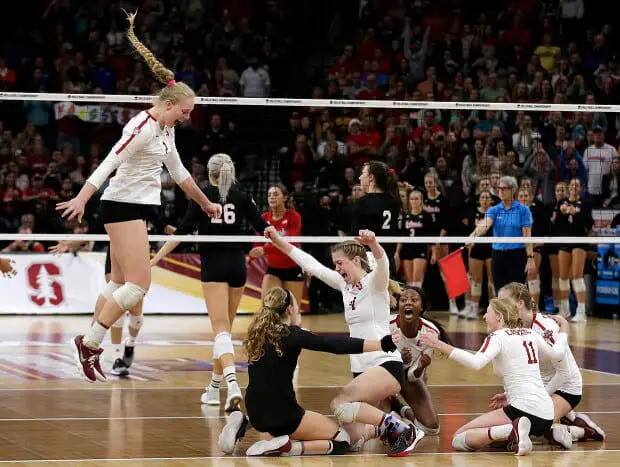Volleyball, although looking like a simple game with limited variations, is actually very in depth and complicated.
With this comes a long list of Volleyball terminology and jargon. In this article I am going to cover a large range of these terms so whether you are a player, fan or simply a spectator you will never feel left out.
Table of Contents
Volleyball Commonly Used Terms
Volleyball Sets
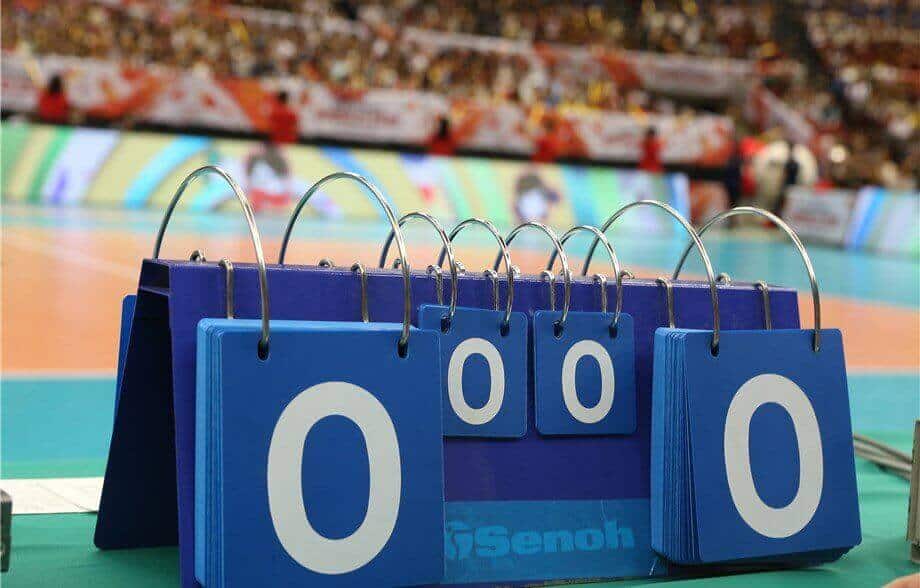
Now I know this one may be confusing as you may have heard this term used when a person pushes the ball upwards for a teammate to spike or attack the ball, however a volleyball set is actually the term used to describe a single game in volleyball.
A volleyball set when playing indoor volleyball is played to 25 points. However, a team must win by 2 clear points so if the score is 25-24 the winning team must win the next point to win the set. In volleyball it is best of 5 sets, where the score line is 2-2 in sets a 5th set is played however it is only played to 15.
Volleyball Match
The volleyball match consists of the whole event from the first whistle to the winning point.
A volleyball match is made up of various sets as indicated above.
The match is best of 5 sets meaning a team can win 3-0, 4-1 or 3-2.
Point
A point is how score in volleyball. A point can be won in a number of ways, such as hitting the ball in, playing the ball out of bounds off an opponent or by the other team making a mistake or an illegal move.
Rally
A rally in volleyball is the action of repetitive play, A rally in volleyball runs from the moment the ball is served to the moment a point is won.
Fault
A Fault in volleyball is an illegal movement, action or task. It simple terms it is anything that violates the rules.
Some examples of faults would be as follows:
- A player touching the net
- Hitting the ball into the antena or aerials
- One team has more than their 3 allocated touches
Dig

A dig in volleyball is the action of passing or picking up the ball from a hard driven hit or shot from the opposition.
Volley
A volley is another name to describe the action of playing the ball with both hands in an overhead motion.
To perform a volley a player would place their hands above their head with their fingers spread. The player would want to create a bowl shape using their hands and fingers.
This allows the player to cover a large surface area of the ball so that they can gather the ball before quickly releasing it by extending their arms and hands together.
For a full breakdown of this skill please refer to my article on setting here.
Spike
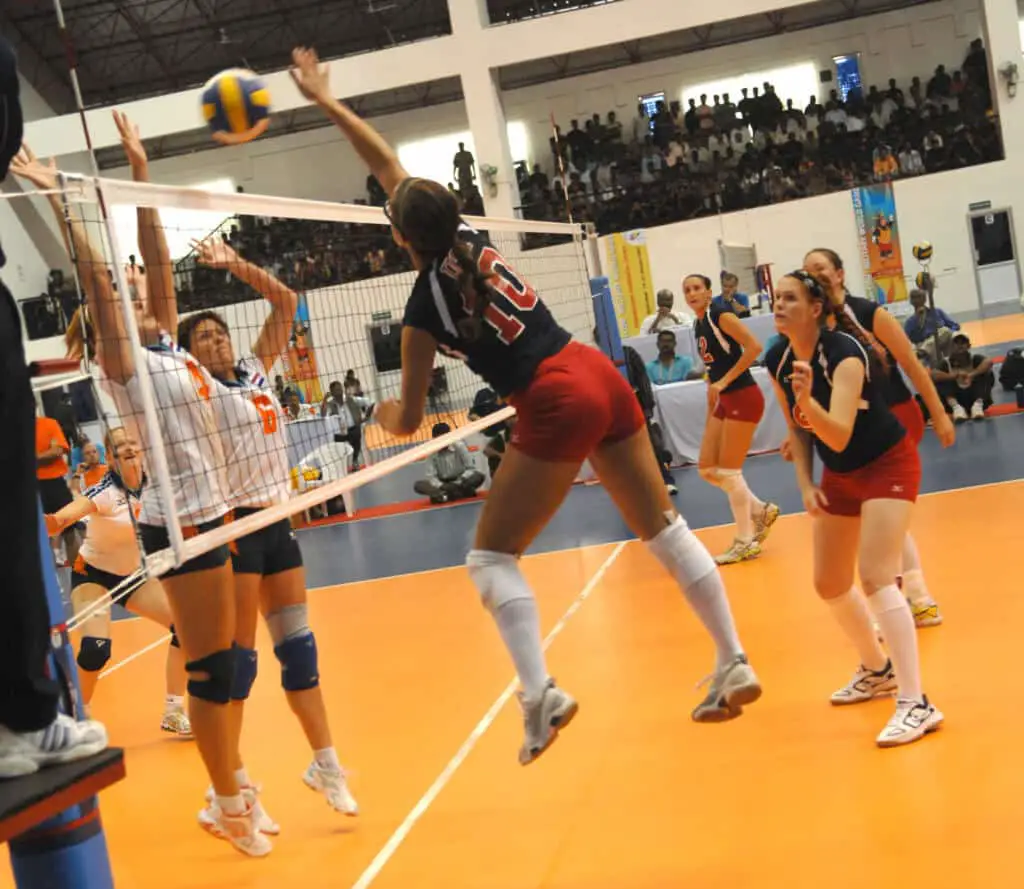
A spike is another name for a hit or attack in volleyball. The spike traditionally is the third touch.
The spike is normally a description used on a particularly hard swing or attack.
Attack
An attack much like a spike is another name for a hit in which someone is trying to win the point with a hard hit.
Rally Scoring
Rally scoring is a variation of scoring points by which a team gains a point every time they win a rally be that whether they started the rally receiving or serving.
Side Out
A side out is the term used when the receiving team is able to win the point from the serving team.
Once a point is won the receiving team who just won the point must all rotate one position clockwise.
Side Out Scoring
Side out scoring is the other type of variation of scoring points used to determine the outcome of sets or games.
Side out scoring is when a team scores a point when they are the serving team. This means if the receiving teams wins the rally they do not earn a point, they instead earn the opportunity to win a point.
Player Actions and Terminologies
Attack
Now I know I have already noted this one above but as it is a player action I felt it best to include it again so.
An attack much like a spike is another name for a hit in which someone is trying to win the point with a hard hit.
Hitter or Spiker
A hitter or spiker is another name for a player who is attacking the ball with the intention of winning a point.
A hitter or spiker can be used to describe any of the following player positions:
- Outside/ wing hitter
- Opposite
- Middle
You may hear before a ball is served the opposition call out something like ‘back court setter, 3 hitters’ This tells everyone on the team that any of the opposing players on the front court are likely to be set.
This also allows you team to know that they don’t have to block the setter as it is illegal for them to attack the ball from within the 3m (10 Foot) line.
Set
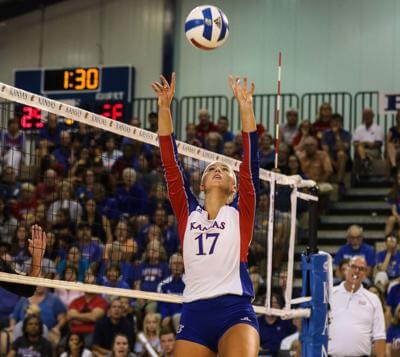
A set is the action of placing the ball in a specified area for one of your teammates to spike, hit or attack the ball.
This is normally done by utilising the volley but occasionally will be done using an underarm bump.
Depending on what position the person is setting the ball to which greatly affect where they try and set the ball to.
For example if they are setting a wing hitter the aim would be to get the ball comfortably above the height of the net and just inside the aerials.
Setter
A setter is a position in volleyball where their job is to assist their teammates by using the aforementioned setting action to get the ball into an area for the attackers to hit.
Bump Set
So know we know what a setter is and more specifically a set or volley, you may be wondering what you would do if you can overhand set the ball.
If the ball is not passed high enough it may not be possible to set the ball using an overhead action such as volleying. In this occasion we still need to be able to set the ball to a teammate.
This is where the bump set comes into play. Using an underarm digging action you can still set the ball to a teammate without needing to overhand set. This can be very useful in your team aren’t strong passers or alternatively playing a team who is very good at serving.
Kill
A kill is used to describe the action of winning a point by carrying out a successful attack.
An example of this would be a wing hitter spiking the ball and making it land on the opponent’s side within the lines
It is called a kill as it signifies the end of the rally.
Overhead Pass
An overhead pass as the name suggests is when you pass the ball that is above your head. Normally you will pass the ball using the volley motion previously described.
Generally speaking you will have much better control taking the ball overhead with a volley as opposed to using your forearms.
This is particularly helpful when receiving a float serve as it allows you to stand nearer to the net, thus shortening the distance the ball travels which in turn ensures the ball doesn’t change direction as much.
Block
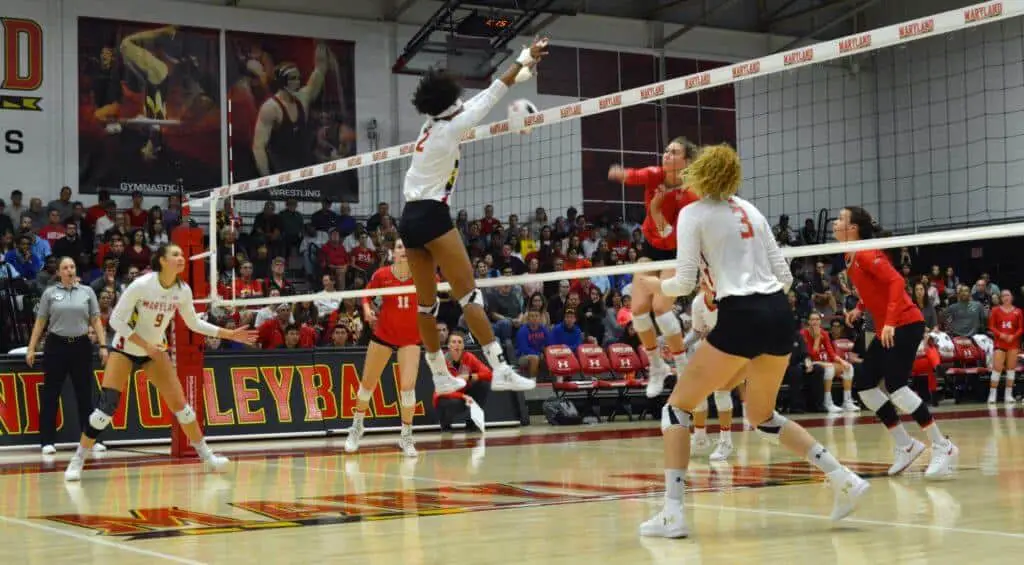
A block is when a player or players on the defending team jump by the net with their hands and arms upwards and over the net in front of the attacker. The purpose of a block is to try and prevent the other team from attacking or spiking the ball.
Tip
A tip is a type of shot used in volleyball. The tip is executed by jumping as if you are going to attack the ball but gently pushing the ball over the top of the blockers.
The aim of this shot is to go over the blockers but drop the ball short so the defending players in the back row can’t reach the ball.
You will often hear the blockers call tip to their teammates to give them more time to react, thus increasing the chances of picking up the ball.
Dump
A dump is when a player throws the ball down on the opposition side much like a rubbish truck dropping waste on a landfill site.
This is commonly done when a ball is overpassed and the defending team jump up and throw the ball down.
Alternatively this can also be used when a ball is over passed but still reachable by the setter. If the setter is front court they may choose to jump and throw the ball down on the opposing side rather than set a teammate.
Reverse Set
A reverse set as the name suggests is when you set the ball behind your backwards. This skill is obviously done blind so a good relationship with your player is needed as well as a consistent setting action to ensure you can give your teammates the same set each time.
Coaching Terminologies
Coach
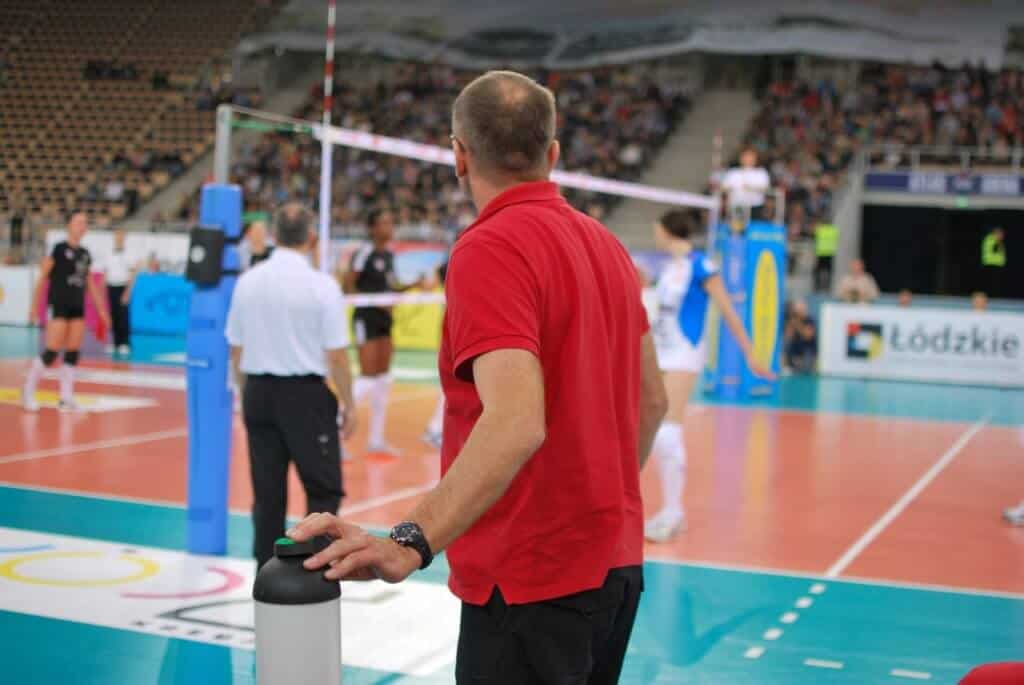
The coach is the manager of the team. They are responsible for making all the major decisions with the team including but not limited to, deciding starting lineups, player positions, substitutions and game plans.
It is also their responsibility to call time-outs and discuss any issues they have with referees regarding certain decisions
Officials
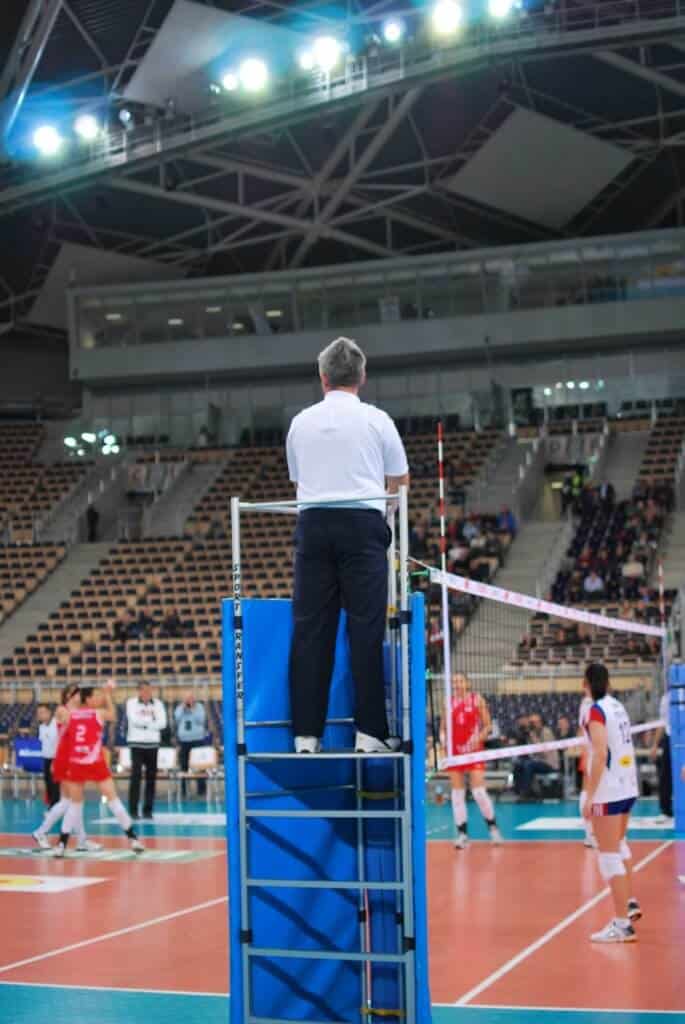
The officials are a team of people in charge of overseeing the game and are responsible for determining whether which teams wins the point.
The officials comprise of referees, a scorer and line judges.
There is a 1st referee who is responsible for making all final decisions.
The 2nd referee is responsible for notifying the first referee if a net touch or similar fault occurs.
The scorer is responsible for not only keeping score but also ensuring players are serving in the right order.
Out of Rotation
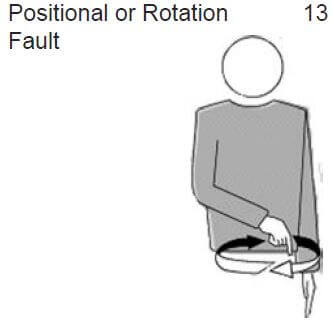
So you may have seen a point awarded to a team before the second the ball is served and wondered what had happened.
In volleyball it is very important that all players are standing in the correct order at all times.
If when the ball is served the team is not stood in the correct order the referee will award the point to the serving team and call a rotation error.
For more information of rotations and player positions I would suggest reading my article on volleyball rotations.
Reaching or Hand Over
In volleyball it is illegal to play the ball on the opponent’s side in nearly all cases. If the ball is played on the opponent’s side a reaching or hand over fault will be called and the other team will be awarded the point.
Now there are a few exceptions to this rule, if the opposing team has used their third touch or if the ball is going to end up on your side then it is not illegal to play the ball on the opposing team’s side.
A common example would be when a team is blocking an attack it is common to reach up and over the net into your opponent’s side to reduce their hitting angles
Lift or Carry
A lift or carry it a fault that can and will be called in volleyball.
A lift or carry is when the ball is settled and remains in contact with the player for a long period of time. A good example of a carry would be when a setter is volleying the ball.
If the setter collects the ball and holds it too long before releasing the set this would be a carry.
A good example of a lift would be a player using an open hand to trying to pick up a volleyball. You may have seen players before collect the ball just above the floor and seemingly lift it upwards rather than hit it upwards. Hence the term lift.
Double Touch
A double touch is another common fault called in volleyball. As the name suggests this is when a player has two consecutive touches of the ball.
A double touch is commonly called when volleying during a set. This is because when you volley you use both hands, if the ball leaves your hands at slightly different times this would be two touches or a double touch.
A common tell is if the ball has a severe amount of spin, however spin doesn’t always indicate a double touch so be careful it definitely is a double touch before blowing the whistle or appealing to the referee.
See below table for all these different calls.
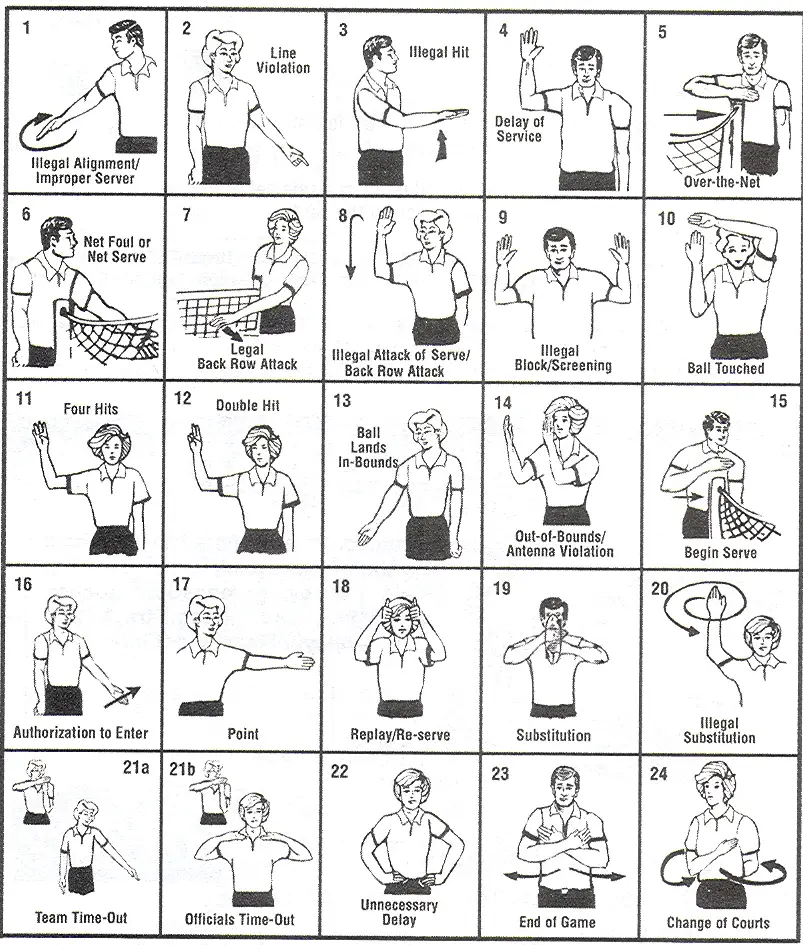
For more dubious rules in Volleyball be sure to check out my article here. In that article I cover some of the most challenging decisions in volleyball and shed some light on the right answers once and for all.

